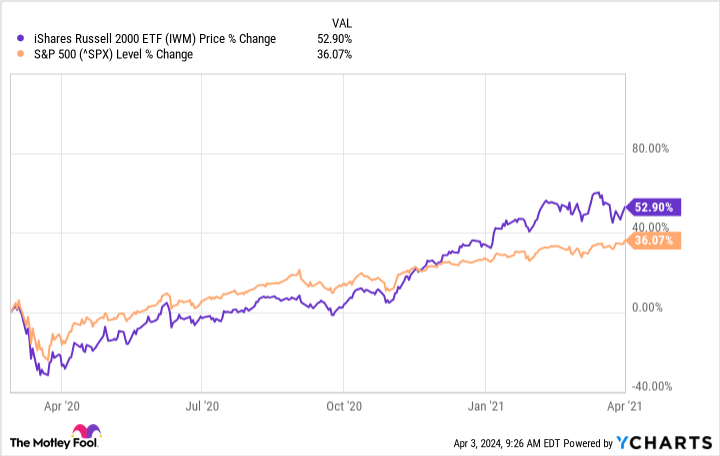These exchange-traded funds cover the full spectrum of company sizes and geographic locations, giving investors broad exposure.
One of the best things you can do when investing for retirement is to have a well-rounded portfolio. Investing is a long game, but it’s especially so when investing for retirement. Having a well-rounded portfolio reduces risk and positions investors’ portfolios to provide better long-term returns.
The good news is that building a well-rounded portfolio doesn’t require picking out hundreds of individual stocks on your own. It can be achieved with a few exchange-traded funds (ETFs). Here are four below.
1. iShares Russell 2000 ETF
The iShares Russell 2000 ETF (IWM 0.33%) tracks the Russell 2000, an index composed of the smallest 2,000 companies in the Russell 3000. The Russell 2000 is generally considered the primary benchmark for small-cap stocks, similar to the S&P 500 for large-cap stocks.
Generally, investing is a matter of risk versus reward, and small-cap stocks exemplify this principle. The shares of smaller companies (with market caps between $300 million and $2 billion) are often more prone to volatility and susceptible to broader economic and market conditions. However, their smaller sizes also give them a lot of room for growth. And where there’s room for growth, there’s room for investors to make money.
With a portfolio that currently contains 1,950 stocks, the iShares Russell 2000 ETF’s diversification ensures investors aren’t too exposed to the risks that come with owning individual small-cap stocks. It’s a great way to be invested in the broader small-cap market, which often outperforms the broader U.S. stock market during bull markets and growth periods. A good example is the growth after the drop that occurred at the beginning of the COVID-19 pandemic.
2. Vanguard Mid-Cap ETF
Mid-cap companies (those with a market capitalization between $2 billion and $10 billion) can offer investors the best of both worlds. They are fairly large, so they typically have a decent amount of resources at their disposal, which helps provide them with a bit more stability. On the other hand, they’re also small enough to offer good growth opportunities for investors.
The Vanguard Mid-Cap ETF (VO 0.87%) is a good choice for those seeking exposure to that segment of the market. The ETF owns shares of more than 330 companies across all major market sectors.
The Vanguard Mid-Cap ETF is also a low-cost option, with a 0.04% expense ratio, so you don’t have to worry too much about losing your gains to fees. It might not seem like a big deal, but it adds up.
3. Vanguard S&P 500 ETF
The S&P 500 is the stock market’s main — and most important — benchmark, tracking 500 of the largest public U.S. companies. If there’s one investment that could (and probably should) be the foundation of your portfolio, it’s an S&P 500 ETF.
There are various S&P 500 ETFs, but my preferred choice is the Vanguard S&P 500 ETF (VOO 1.06%) because of its low 0.03% expense ratio.
The Vanguard S&P 500 ETF holds shares of some of the most important companies to the U.S. (and global) economy — so much so that an investment in the S&P 500 ETF is often viewed as an investment in the broader U.S. economy. If you’re investing for retirement, betting on the U.S. economy for the long term is one of the safer bets you can make.
The stock market is inevitably volatile, but the S&P 500 has proven that, over the long run, it heads in a positive direction despite any short-term slumps it may experience. Historically, it has averaged around 10% annual returns long-term, which is favorable enough to boost your savings for retirement.
Past performance doesn’t guarantee future performance, but it’s a good indication of the value the Vanguard S&P 500 ETF can provide.
4. Vanguard Total International Stock ETF
International markets are broadly divided into two groups: developed and emerging. Developed markets have more advanced economies, established industries, and better infrastructure while emerging markets generally have developing infrastructure, younger capital markets, and less stable economies.
The Vanguard Total International Stock ETF (VXUS 0.37%) exposes investors to both developed and emerging markets. It’s one of the simplest ways to invest in international economies as a whole.
Similar to the risk-reward trade-off between companies of various sizes, there’s a trade-off you make with companies in developed versus emerging markets. Developed markets are typically more stable and reliable because of their more mature economies. Emerging markets may be riskier because of external factors, but they also have a lot of upside when they work out well.
A truly well-rounded stock portfolio should include international companies. If you’re only investing in U.S. companies, you’re missing out on some great companies and could be doing yourself a disservice.
Stefon Walters has positions in Vanguard Index Funds-Vanguard Mid-Cap ETF, Vanguard S&P 500 ETF, and Vanguard Star Funds-Vanguard Total International Stock ETF. The Motley Fool has positions in and recommends Vanguard Index Funds-Vanguard Mid-Cap ETF, Vanguard S&P 500 ETF, and Vanguard Star Funds-Vanguard Total International Stock ETF. The Motley Fool has a disclosure policy.




